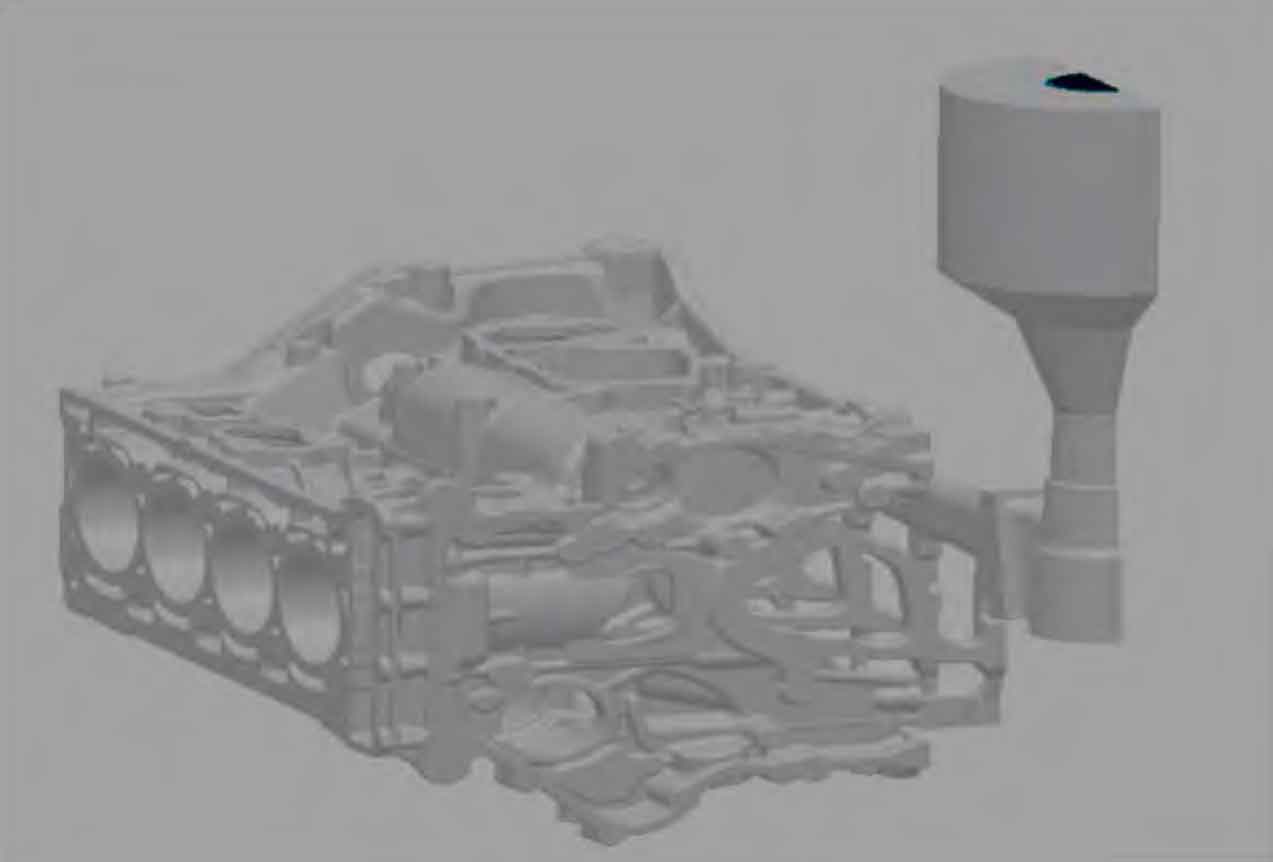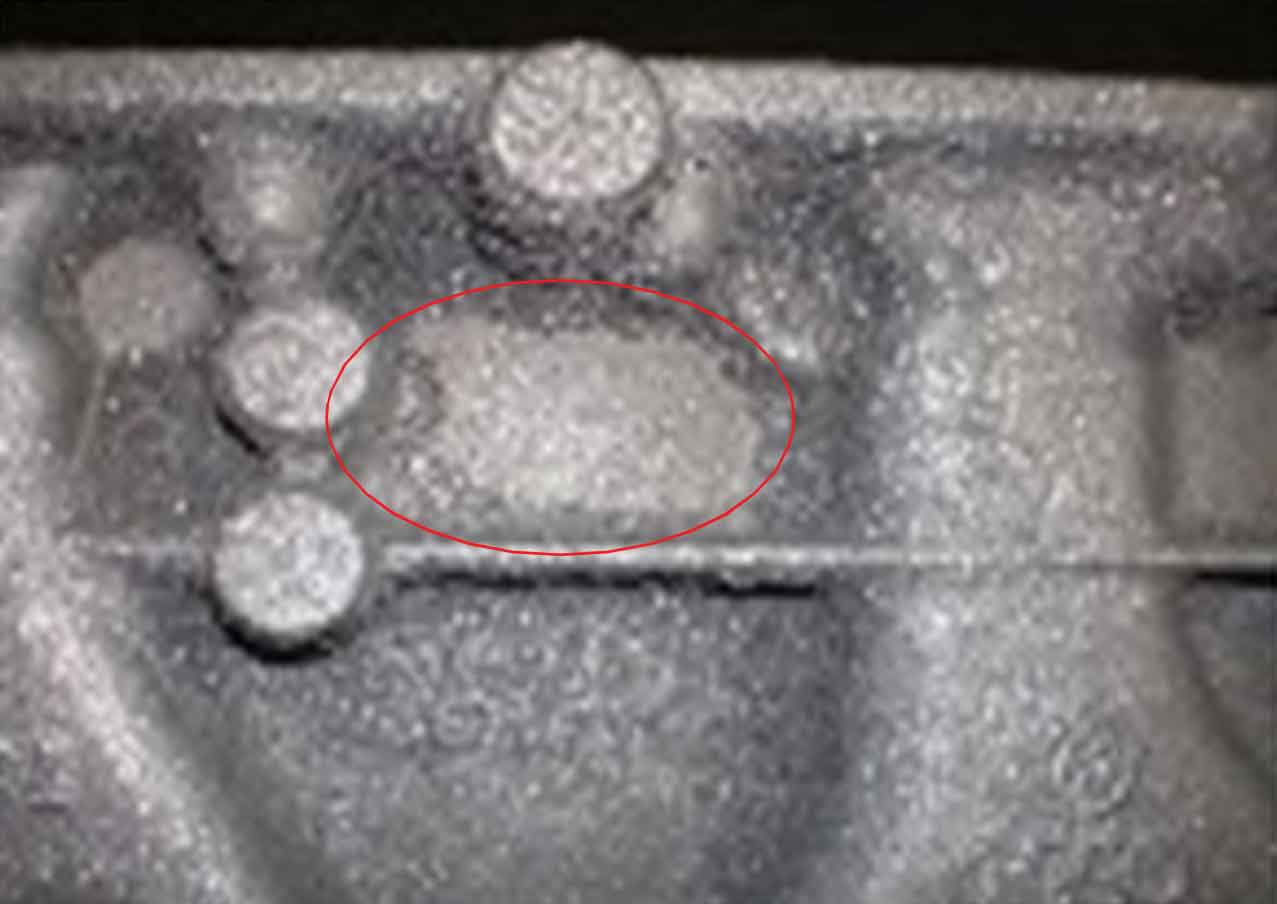1. Defect description
The cylinder block is a horizontal horizontal pouring process (as shown in Figure 1), with complex structure and wall thickness of (3.5 ± 0.8) mm. In order to ensure the forming of the cylinder block and reduce the generation of casting defects (pores, etc.), high temperature pouring is adopted, and the temperature is controlled at (1450 ± 10) ℃. The surface of the produced castings is prone to sintering sand sticking defects, especially at the lower surface close to the inner sprue flange. Due to the large amount of molten iron flowing through, the sand sticking is more serious (as shown in Figure 2).
2. Adjust molding sand process parameters
2.1 Grain size of refined sand
As a large number of 50 / 100 mesh core sand flows into the sand system, the grain size of mold sand continues to coarsen. In order to refine the grain size, 70 / 140 mesh raw sand is added into the system to change it from 50 / 100 mesh 3 sieve sand to 50 / 140 mesh 4 sieve sand, reduce sand mold pores, increase sand mold pore resistance, improve the critical pressure inside the mold, and prevent the formation of surface roughness and sand sticking defects due to the infiltration of molten iron, but the grain size of mold sand is too fine and the permeability of sand mold is poor, Castings are prone to porosity defects. After many tests, the average fineness of molding sand is controlled at 57 ~ 62, which can meet the quality requirements of castings.
2.2 Increase the back pressure of sand mold gas
The gas back pressure of sand mold refers to the gas pressure of sand mold pores, which depends on the gas generation and permeability of molding sand. With large gas generation, low permeability and large back pressure, it is difficult for molten iron to penetrate into the sand mold. After many tests, it is verified that adjusting the gas output of molding sand from the original 14 ~ 17 ml / g to 18 ~ 22 ml / g not only increases the purpose of sand mold gas back pressure, but also reduces the defects of casting pores, which also plays a positive role in preventing sintering and sand sticking of castings. However, if the air output of molding sand is adjusted too high, it will not only increase the tendency of pore defects, but also easily cause water explosion in molding sand, which will aggravate the sand sticking defects on the surface of castings.
2.3 Control the temperature and moisture of used sand
For every 1% of water evaporated in the sand, the sand temperature can drop by about 25 ℃. Due to the loss of the humidification and cooling function of the double disc cooler of the author’s company, in the high-temperature season, the sand temperature sometimes reaches more than 50 ℃ and the water content of the old sand is less than 0.5%. The contradiction of sand sticking of castings is very prominent. Therefore, a water spray device is installed on each old sand belt to penetrate step by step, and the steam generated by evaporation is blown away by a fan to achieve the purpose of humidification and cooling. After the implementation of the scheme, the sand temperature is lower than 50 ℃, and the moisture of the old sand reaches about 1%. Although the ideal effect is not achieved, the defect of sand sticking on the surface has been further alleviated.
2.4 Adjust the compactness and moisture ratio
The optimum ratio of compaction rate and moisture is the key parameter to ensure the stability of molding sand performance. It should be adjusted according to different seasons and sand temperature to prevent the loss of moisture of active bentonite during transportation and change the performance of molding sand. The production experience of the author company proves that when the ambient temperature is more than 10 ℃ higher than the sand temperature or the sand temperature is more than 45 ℃, the best ratio between the two should be controlled at 14 ~ 16; On the contrary, the best ratio is controlled at 11 ~ 13, and the moisture content of molding sand is always in a reasonable range to meet the requirements of production and quality.


